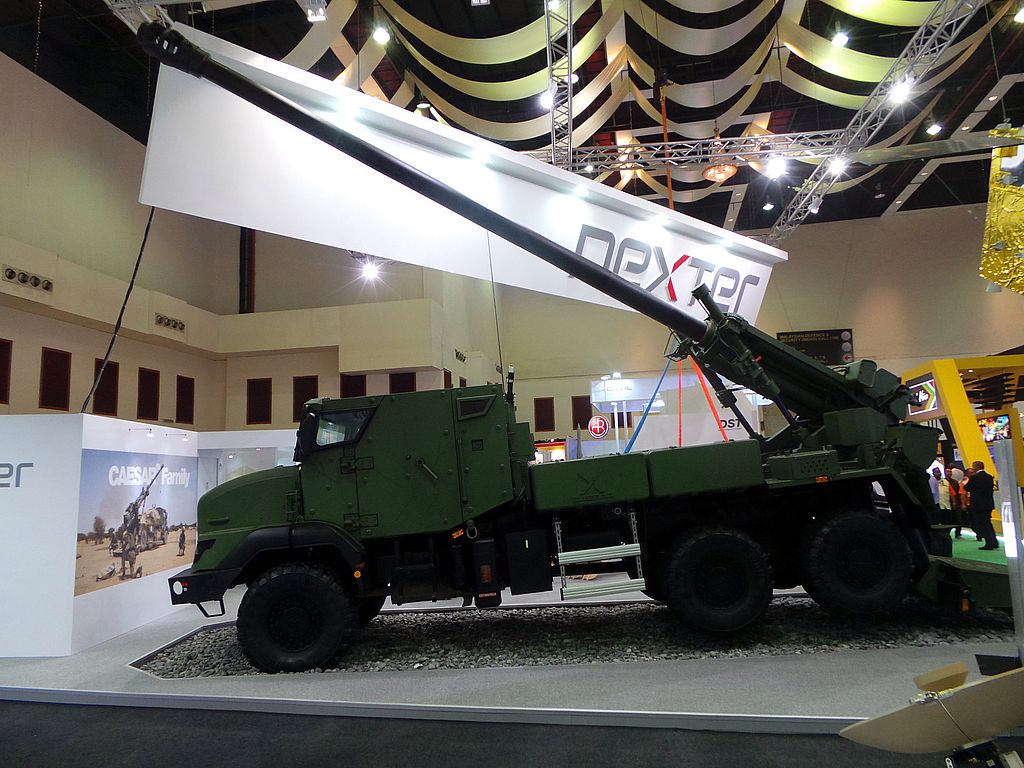
KUALA LUMPUR: THE Nexter Systems Caesar 155mm truck-mounted self-propelled howitzer returns to Malaysia after some 20 year absence. This time around at DSA 2016, the Caesar 155m 52 calibre howitzer gun is mounted on the Renault Defense Sherpa 5 up-armoured truck.
Apart from the Caesar, Nexter Systems is also displaying its LG1 105mm light howitzer at DSA and its host of ammunition from 20mm shells to 155mm calibre rounds. The LG1 has a maximum firing range of 19 km with extended rounds. It could also be deployed using the Nuri and the EC725 helicopters.
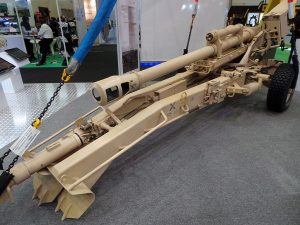
Today Nexter Systems signed a Letter of Intent for collaboration with Advanced Defence Systems Sdn Bhd (ADS) to promote, assembled and maintain the Caesar in Malaysia.
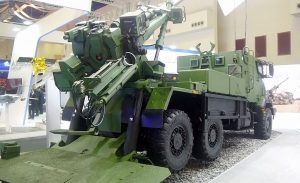
If contracted with the Malaysian Army, ADS will set up a Caesar assembly and maintenance facility while Nexter Systems will provide the required technology and know how to assemble, integrate and maintain the Caesar SPH systems.
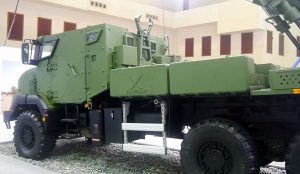
According to ADS chairman Datuk Abdul Hadi Abdul Razak their offer was for the Army to purchase 20 Caesar SPH, initially. 18 will be part of an artillery regiment while the other two will be used for training purposes.
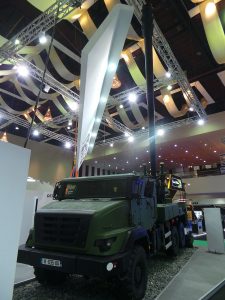
He said depending on the Army’s requirements they could also offer fire-control solutions mounted on the same Renault truck. The Army could choose the un-armoured variant of the Sherpa 5. “It will depend on the requirements of the Army”.
Abdul Hadi, a former Kor Artileri Di Raja commander, was involved in the initial testing of the Caesar when it was brought to Malaysia back in 1995. He said the KAD had identified the need for a SPH regiment back then but until now the requirement have yet to be fulfilled.
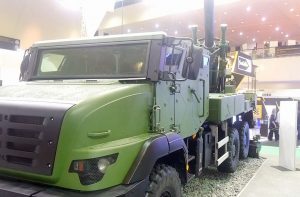
According to Abdul Hadi unlike a tracked SPH, the Caesar’s low weight, less than 18 tons in combat configuration, reduces both complexity and cost. Its strategic, operational and tactical mobility is superior to that of other systems, while matching the reactivity of the self–propelled guns and the light weight of the towed guns.
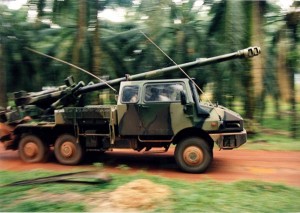
He also said the Caesar could easily be integrated into the Army’s C3I infrastructure easily. Furthermore, he pointed out that the truck mounted SPH could self-deployed to anywhere in the peninsular within hours of being alerted.
The Caesar is also transportable by air on both RMAF air-lifters, the C130 Hercules and the Airbus A400M unlike tracked howitzers.
— Malaysian Defence
If you like this post, buy me an espresso. Paypal Payment

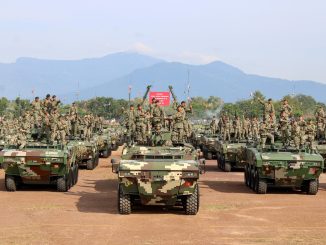
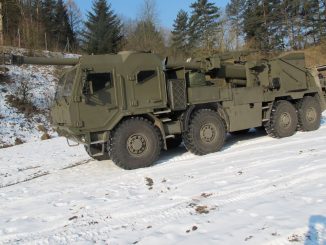
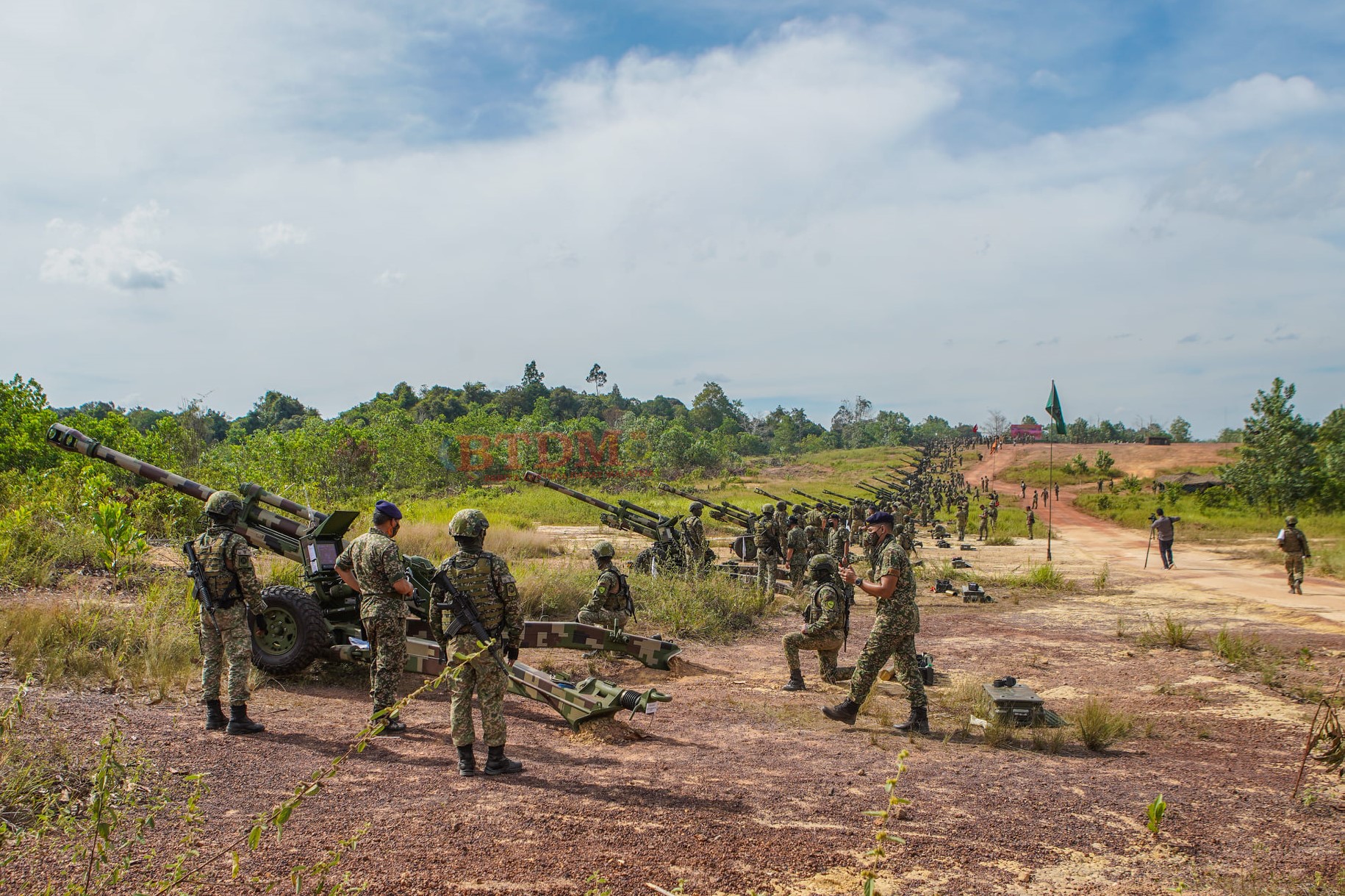
First it depends on money : ]
Then it depends on doctrine and operational requirements.
If we have a need for arty to keep pace with armoured or mobile formations over rough terrain; then a tracked based solution is the answer. If however armoured or mobile formations will not be moving rapidly across rough terrain but will be operating mainly in areas where there’s are paved roads or in areas such as palm oil estates,etc; then the answer is a wheeled based solution. Wheeled or tracked? Each has its merits.
There is also the key question of what we foresee our arty doing in a future state on state conflict? During the 2nd Emergency we were lucky in that the bad guys had no arty. Arty spent most of its time in direct support of infantry units and the occasional fire harrasement mission following an engagement. In any future clash with non state actors [i.e. Lahad Dato], our arty would be doing the same but with state actors, arty would, in addition to providing direct or indirect support to units; would also be doing stuff like counter battery fire or deep penetration missions [on paper this is beast performed by MLRS however]. Slightly complicating matters is that the opposition will have the means to fire back at our arty and that targets will be shifting.
Then there is also the question of how much decentralisation and centralisation we need; i.e. brigades have operational control of artillery Regiments but control should be passed down to battalion level when there is a need [off course there are operational and logistical issues here]. The infantry battalions on their part should also increase the number of people trained to call in arty and the time it takes from the time a fire request is received, to the time rounds fall on target should be decreased.
No point having Arty Regiments under operational control of Brigades if the battalions being supported can’t get their support on time. And no point getting new arty with ”range” and ”firepower” if we can’t ”see” targets or hit those targets on time, if infantry units don’t train with arty units on a regular basis or if we don’t have adequate stocks of ammo or we have adequate stocks of ammo but we can’t get them to where they’re needed in time … In short there are so many factors to consider before we can even talk of how effective our arty will be.
Very easy solution. Since there are so many complucated issues we should not buy artillery at all
Azlan “If we have a need for arty to keep pace with armoured or mobile formations over rough terrain; then a tracked based solution is the answer. If however armoured or mobile formations will not be moving rapidly across rough terrain but will be operating mainly in areas where there’s are paved roads or in areas such as palm oil estates,etc; then the answer is a wheeled based solution.”
Perhaps when it comes to 52 caliber artillery systems, the considerations are different from the tactical vehicles they are supporting. Because of their long range, they may be able to to keep to roads or firm ground and still keep the supported unit’s frontage under cover.
Take the example of the wheeled HIMARS. It has been more popular recently than its predecessor the tracked M270, both in the US armed forces and in exports. Users have realised their environments have enough firm ground to strike the majority of targets. These vehicles can move around their territories more quickly, by land and air, eg by taking bridges that are unable to support the weight of tank-sized tracked vehicles.
In my limited experience, the decision between tracked and wheeled vehicles also involves the characteristics of these wheeled vehicles.
I have seen troop movements in very sodden ground. There were the standard prime mover trucks, medium trucks and light tactical vehicles (which in civilian terms would fit in the light truck category). All of these vehicles had 2 axles. But only one vehicle got stuck, the medium truck that was close to its maximum load AND the only one that lacked 4 wheel drive.
I wouldn’t know about the ground pressures, weight and so on on the vehicles I saw. But I would think the 17 ton Caesar system on its 3 axle truck has a lower ground pressure than most military vehicles.
Caesar 155mm is nice, and personally I think the number of 155mm that we have is on the low side (even with the possible acquisition of Paladin).
But I think in the aftermath of LD incident, while the military literally bombed the intruder to pieces for more than 2 hours, I still think we need to improve upon our light artillery, which includes the 105mm howitzers and mortar. I think the LG1 light howitzers(and the M119) should be considered since it has twice the range of Oto melara pack gun, while 120mm mortar basically have roughly equivalent range as oto melara but with larger munition (almost as big as 155mm shell afaik)
Lee Yoke Meng “Very easy solution. Since there are so many complucated issues we should not buy artillery at all”
With so many different choices, I’m surprised you don’t want to carefully study the best gun for our needs.
Buying whatever your heart feels like that you suggested in the past (JF-17, Chinooks, squad level mortars, armed to the teeth OPVs) is not the solution.
Academic aside…its time to equip what ever is ready n available for the men in green…when push comes to shoves we will even use ww2 pounder to aim at the general direction of the enemy n fire off crates after crates just for deterence n fear effect…even the tongkang will be armed to the teeth if ever uncle Sam decided not to kay poh in the SCS….wind of change will come when the new president come into power….my 2 cents
Lee – ”Since there are so many complicated issues we should not buy artillery at all”
Instead of making sarcastic comments [which anyone can do], why don’t you share with us your opinions as to the changes that the Royal Artillery Corps needs to get on with the times.
Buying the gun is easy, getting the gun to perform to its best is the hard part…. involving ”complicated issues” [to quote you] which call for deep thinking and innovativeness. BTW, as an ex serviceman, you of all people surely knows that everything; whether basic infantry skills, logistics or combined arms tactics; involves ”complicated issues”.
Alex – ”But I think in the aftermath of LD incident, while the military literally bombed the intruder to pieces for more than 2 hours”
First ask whether the arty strike actually made a difference to the final outcome and whether any Sulu gunmen were actually killed by a M1 HE round …..
Alex – ” I think the LG1 light howitzers(and the M119) should be considered since it has twice the range of Oto melara pack gun,”
Range is important but first we have to ensure we can hit what we aim at and that we can mass fire. The key is ”mass fire” [not mass guns] whether fired indirectly or directly and whether the fire mission is observed or unobserved. History is full of armies who had guns with ”long range” [which some are so enamored of]but couldn’t take advantage of that ”long range” because of various deficiencies.
AM – ”With so many different choices, I’m surprised you don’t want to carefully study the best gun for our needs.”
Yes. Instead of routinely falling back on ”sarcastic mode” and giving the impression that ”long range” and firepower” is a panacea and more important than anything else; it would be more interesting if Lee would share with us his thoughts on how the Royal Artillery Corps can evolve to deal with future threats, i.e. what changes are required for doctrine, organisation, coordination with combat units, etc.
I would argue that in contrast to infantry and armoured units; the Royal Artillery Corps has much more catching up to do with regards to keeping up with the times – its doctrine and organisation hasn’t changed much from the days of the 2nd Emergency; irrespective of the new gear it has acquired over the years. Before someone accuses me of neglecting the lessons learnt from the 2nd Emergency; I will point out that a lot of the lessons learnt are still valid but not all; given that times have changed and that the operational circumstances faced then were unique to that conflict.
Indeed there are ”complicated issues” involved but then waging war is probably the hardest endeavour known to mankind and unfortunately; ”complicated” stuff like doctrine and organisation [to name a few] determines how effectively armies perform. If only, how effective artillery units will perform is a simple as the type of gun we acquire and the maximum range it has …..
If you are to ask me, the artillery is easily the queen of the battle field. Let us ask ourselves. What wins a war?. It depends on the strategy adopted. One is disregard technology n go for massed human warfare versus massed technology superiority. This technique was adopted by the chinese n vietnamese in their strategy. But time changes. Even china has to cut down the size of its army by 300,000 troops n go for tactics n technology to win wars.
If we look at history of the korean war, both sides used massed firepower both before an attack n during an attack to pin down n break up the attack. So artlillery is both a weapon of attack n defence. The bombardment need not kill a lot of soldiers. All they need is to stun the defenders n make them disorientated during the advance to contact phase. This will give the attackers time to close up with the enemy.
On the defensive side, the artillery can be used to attack during the massing of troop phase to break up the massing. This will either stop the attack or reduce the weight of the assault.
So what do we need in the artillery?. On the strategic side our investments in the rockets is a good decision. However, our unguided rockets cannot hit with precision. We need to buy the gps guided version when it comes out. This will add accuracy to attack high value targets.
On the gun side, we need to add to our short range/light artillery system. The Italian pack howitzer system we have is outgunned at present due to its short barrel n short range. Modern light guns can easily outrange this pack howitzer. However, its the only gun that can be disassembled n carried by bombardiers into hard to reach areas. Forget the shield. However in modern warfare n with artillery n mortar tracking radars this is rather hard to do shoot n scoot. So mostly our current light guns are all within range of any enemy’s light guns. Range is thus important for self preservation n for mobility especially when undertaking urgent max range fire support. To cover a certain length of front, we need guns with good range as compared to guns with shorter ranges. For effective fire support we also require these guns to fire in a battery level n not single guns like in the emergency days.
In an artillery battle, guns with a shorter range will always need to move after firing but no matter where they move to, they must move to a place where they can reach the target for the next shot. Thus it must move in a semi circle. Whereas the guns with a longer range just wait n all they need to do is wait for the next shot n they can turn their aim to fire for effect.
Some have said no need to have fire power n no need to have range. Range n fire power is just rubbish. But let me say this. Range n firepower equates to survival of our men.
Artillery battalions have trained FOO’ embedded with the front line n special observers are available to spot n correct fire. These are brave people as they often goes with recce patrols into enemy territory to pre register targets .
Many says its pointless to have firepower in the infantry as they need to carry plenty of amno. Thats why we train the infantry to do. Look at a modern battlefield. In Afghanistan the us infantry section of 8 men carry 4 saw’s. They too need to dismount n fight especially in the green zone. Looking back at both the emergency n confrontation, in an ambush the enemy always make sure that they have an advantage n a heavy volume of firepower.
In the infantry, the first stage of combat is calked “winning the fire fight”. What is winning the firefight?. It is whichever side can pin down the oppossing side by sheer weight of firepower. If we cant run the firefight we are gone. Reason is we cant move. Cant even withdraw but just lie down n get hammered. The only way to allow for counter attack is to win the fire fight. Pin the enemy down instead. Of course, a brave charge that would win a pgb or two would also be great but can we accept the casualties?. Remember that the lives of our men are in our hands. We dont want widows n single parent kids as far as possible. So equipping our sections with 2 saws is great as compared to one only now. Light mortars n grenade launchers are great in open areas but in a closed environment may not be practical.
So coming back to arty, we need both towed n self propelled arti in the 155mm class for long range. Buy the 52 caliber guns that has longer ranges. Then buy more modern 105 light guns. These are light guns n can be towed. We need a combination of both tracked n wheeled guns. Having just wheeled guns make our options for firing more limited n the enemy can guess or use recce means to concentrate in certain areas to locate our guns. If we have both the options become wider n more difficult to guess or need to expend more time to cover all posdibilities. Range n firepower is the winning formula. Just ask any serving officer or men
1) more firepower.
This is addressed by the army by having fire support company in every battalion. They are equipped with 81mm mortars and 0.50cal machine guns.
More firepower is also now available within the infantry section, with 2 rpg and 1 mgl to add to the single saw.
155mm is more towards supporting the movement of large formations, and here also the army is moving towards the right direction in adding sph to its inventory. So it is not like the army didn’t plan to add more 155mm’s.
2) precision strike.
This is a good thing to have, but not really necessary for the artillery regiment. Precision strike can be done by air (lgb bombs, missiles) for long range and from land (igwe missiles, metis m etc)
By the way, lets move forward and acknowledge the things the army is doing that supports your ideal (like more firepower, which they are doing), and discuss what other methods that the army could improve on, and suggest how they can do it (in a practical, achievable way of course)
Lee – ”Range n firepower is the winning formula. Just ask any serving officer or men”
Lee – ”Buy the 52 caliber guns that has longer ranges.”
Any artillery man worth his salt will also say that having the proper doctrine and organisation are actually more important than ”firepower” and ”range”. As I’ve repeatedly stressed; NO use having ”firepower” and ”range”’ if one can’t mass fire, can’t coordinate the actions of his various arty units and can’t acquire targets. History is ripe with examples of armies that had guns that outranged their opponents yet didn’t deliver the results.
Lee – ”So coming back to arty, we need both towed n self propelled arti in the 155mm class for long range. Buy the 52 caliber guns that has longer ranges.”
Actually, a clear distinction has to be made deep strike and shallow strike. The key problem in hitting undirected targets is not being able to see them. Various other armies have the means to ”see” targets at distances; we don’t; not yet [our handful of UAVs don’t count and are not even organic to the army]. Given that the ARTHURs are organic to an ASTROS regiment; we can surmise that a main role of ASROS would be counter artillery fire or deep strike against targets such as C2, command posts, etc, etc.
Lee – ” It is whichever side can pin down the oppossing side by sheer weight of firepower. If we cant run the firefight we are gone”
Fire effects consists of : ”suppression”, ”neutralisation” and ”destruction” : each different and each producing different results. Fire power alone is not a panacea and is useless without maneuver. The trick is to have the right amount of firepower [by itself useless if one’s logistics can’t keep up] and to maneuver to gain tactical advantage. History is ripe with armies that had ”firepower” but didn’t maneuver and were tactically inept.
Lee – ”Some have said no need to have fire power n no need to have range. Range n fire power is just rubbish. But let me say this. Range n firepower equates to survival of our men.”
Nobody ever said [despite your insistence] that ”range” and ”firepower” are NOT important and NOBODY said both are ”rubbish” [please don’t put words on others mouths]. Despite me repeatedly pointing out that ”range” and ”firepower” are important but are not a panacea and are dependent on several factors; you still insist that ”some” dismiss the value of ”firepower” and ”range”……..
”Firepower” and ”range” are worthless if one does not have the means to take advantage of them; namely having the right ISR assets; the right doctrine, the ability to mass and coordinate fire, the ability to acquire targets at long distance, etc.
Lee – ”However, its the only gun that can be disassembled n carried by bombardiers into hard to reach areas. ”
That was indeed the main selling point of the Model 56 and it’s designation as a ”pack howitzer”. Being able to be broken down into various pieces [the heaviest part is the barrel] is great BUT the main problem is carrying the ammo ”into hard to reach areas”.
Contrary to popular belief, Britain, Australia and New Zealand did not bin the Model 56 because its maximum effective range was only 20km but because the gun is prone to damage when towed’ over rough terrain, at high speeds.
Lee – ” Looking back at both the emergency n confrontation, in an ambush the enemy always make sure that they have an advantage n a heavy volume of firepower.”
This is simply because the bad guys knew they were outgunned and their aim was to inflict as many casualties as possible AND then leave before being fixed by enemy reinforcements or being destroyed by the heavier firepower their enemy could call upon. Sticking to the 2nd Emergency and Confrontation as a yardstick to access future conflicts is silly for the simple reason that times have changes and that future opponents will be better armed than those faced during the 2nd Emergency and Confrontation.
Just in case I’m accused of anything; let me say this [again] : a lot of lessons learnt then are valuable and still valid but NOT all are still relevant.
Lee – ”Many says its pointless to have firepower in the infantry as they need to carry plenty of amno. Thats why we train the infantry to do. ”
Again : nobody said that. You seem to be getting the wrong signals. What I DID say is that talking about extra firepower is great but it has to be carried by someone and that extra firepower has to be resupplied. In any future conflict; the rates of fire will be much heavier than was the case during the 2nd Emergency! Look at the Lahad Dato footage; we can clearly see chaps carrying extra ammo cases.
As I’ve repeatedly pointed out; the BIS sections are already ”top heavy”! They already have a Milkor, an LMG, 60mm mortar, shoulder fired weapons, personal weapons; as well as stuff like ammo and radios. This doesn’t include personal kit, belt order, helmets and if available : body armour!
Lee – ”Range n firepower is the winning formula. Just ask any serving officer or men”
Actually I have ….. Both here and elsewhere.
My comments are not just based on what I read or believe but also on what I’ve heard from people who have/had first hand experience. Take the BIS sections for example and your insistence that they get more ”firepower” : 3 different currently serving people I’ve asked say that they can hardly move when carrying all the issued gear. Another problem they say is that stuff like the Milkor and LMGs are ”hungry”; requiring lots of ammo. Their opinions on having lots of ammo is based on the belief that any future conflict will be of higher intensity than the 2nd Emergency and that troops will have to carry much more ammo than troops on jungle patrols did during the 2nd Emergency.
Lee – ”So coming back to arty, we need both towed n self propelled arti in the 155mm class for long range. ”
There is no clear cut rule : depends ENTIRELY on operational requirements and doctrine.
You will have noticed that many Tier 1 armies have ditched towed arty; there are reasons for this. If we take the Brits for example, the only towed arty the have are the Light Guns operated by the Royal Marines. The Russians on the other hand still maintain loads of towed arty : depends on operational requirements and doctrine.
Lee – ”Artillery battalions have trained FOO’ embedded with the front line n special observers are available to spot n correct fire.
We all know the value of FOOs. My question is simple : Apart from attached FOOS; how many people in an average battalion -today – are actually trained to call in arty?
And another valid question [despite the focus on the actual gun, ”firepower” and ”range’]’ : how often do arty Regiments train with the units they are intended to support?
How well do arty units understand the units they are to support, operate and vice versa?
How often do we have live shoots?
How often can rapidly we shift fire ? [Both were not needed during the 2nd Emergency and Confrontation.
Can we hit unobserved targets with the same accuracy we can with observed targets?
For that matter how many ranges do we have in which we can fire live rounds?
How well can we coordinate all our arty and MLRS assets? What level of centralisation an decentralisation have we planned for?
All these factors are more important than just having ”firepower” and ”range” ….. [which no doubt some people will still dogmatically treat as a panacea [if only it were as simple as that]. All ”complicated issues” [to quote you] no doubt; but then war is a highly ”complicated” affair to begin with.
…… – ”and discuss what other methods that the army could improve on, and suggest how they can do it (in a practical, achievable way of course)”
My opinion is that the Royal Artillery Corps has more catching up to do [compared to other arms of the army] with regards to keeping up with the times. Take the organisational structure for example; hasn’t changed much since the 1970’s! I have no doubt that there are junior or mid level officers that are innovative and are deep thinkers but the problem is the army mindset as a whole : it’s wary of change and to a certain extent, junior officers are expected to toe the line [to be fair this is a problem encountered even in Tier 1 armies].
In short, whatever experiences we had in the past, we need to build on but we should also keep up with the times and just as importantly, don’t assume that just because something has worked in the past, that it will work again or that just because something works for others; that it will also work for us.
…… – ”155mm is more towards supporting the movement of large formations”
No, it’s towards supporting any unit that needs support. It can also be used for deep strike and counter battery [in our case however deep strike and counter battery is best performed by ASTROS].
But before we get into that the Royal Artillery Corps has some core, fundamental issues that need addressing first; namely training, coordination, doctrine, etc. All of which are far more important than the actual gun we have.
Lee ” In Afghanistan the us infantry section of 8 men carry 4 saw’s.”
As a veteran of light infantry, how come this doesn’t strike you as logically impossible, with all the radios, supplies and other weapons to carry, more so in Afghanistan where troops take everything with them on foot in the mountains.
This should be impossible also because the SAW does not have a semi automatic mode and would burn through the team’s ammunition. It would also leave them short members capable of precise aimed fire. Are you sure you are a veteran?
“Remember that the lives of our men are in our hands. We dont want widows n single parent kids as far as possible”
There are many acquisitions that would save lives, but finite resources in any army. Your disregard for target acquisition capabilities is alarming.
People assume that getting the hardware [and the ”firepower” and ”range” that comes with it] solves everything. This argument doesn’t hold water as there are many examples of armies that outgunned and outranged their opponents yet were ultimately beaten. Without proper training, doctrine and the ability to mass and coordinate fire, as well as coordinate its actions with units being supported; having artillery with ”firepower” and ”range” counts for nothing ….The argument that ”firepower” is a panacea is also nonsense as proven in many conflicts. ”Firepower”, without maneuver, training and proper doctrine counts for nothing.
The idea that men in a BIS section can carry extra stuff doesn’t make sense; given the stuff they already have to carry and the ammo needed to feed their ”hungry” weapons. Increasing the ”firepower” is easy but who’s to carry the extra ammo? They have helmets, belt order, personal weapons and other kit. In addition to personal weapons, some have to lug a Mlikor, shoulder fired weapon and radio. We haven’t even added the mortar and LMG yet and the fact that they might have body armour. Any suggestion that the size of the BIS sections should be increased – to carry the extra ”firepower” – doesn’t take into account that the size of the section is intended to fit inside an Adnan.
On the infantry level, all nco’s who ate worth their salt can call in artillery support provided they have guns within range. However, in order to be good at artillery control they need to be excellent when it comes to map reading. They need to give at least a 8 digit map reference to the arty officer. One wrong calculation overestimation would mean an own goal.
They way some of you hit me is really surprising. I make comments without being personal but many hit by mentioning names. Some even question whether i have served.
All soldiers irrespective of just plain recruits are trained to fire their guns responsibly. Its also the responsibility of the nco n officers to maintain fire control. If every soldier is to fire indiscriminately in a battle, thats bad bad news. If they do we load a brand new a400 with ammo also not enough. When in a battle, automatic weapons should be fired on a group shoots only. I.e 3 to 4 bullets per shot. The way to in a firefight is first identify the location of the enemy. Once discovered fire orders will be given n the order can be fire at will or give it a barrage from everyone or more often, those who can see the enemy yo fire. Of fours3 at the time of contact, returning fire is important. In an attack, we need to get the enemy’s head down n even then its burst fire. No auto weapons can sustain fire fir more than 400 rounds without overheating n the barrels needs changing. How heavy are the ammo?. Not heavy unless its the heavy ammo n above. The 5.56 mm bullets are relatively light compared to 7.62mm of yore. Milkor n the grenade?. The grenade occupies a lot of space n must be carried in bandoliers but each weight surprisingly light. Radios?. In a section only one man carries the heavy man pack radio. So i dont understand tge fuss. It has been carried n done before. How come current soldiers cant do it?. .
As for artillery, is not that we don’t have a good strategy or otherwise. Our tactics n strategy is limited by our equipment. If we have only towed pack howitzers that has only so much range ( nots less than 20) no point asking them to do more or devise tactics n strategy which they cant fulfill. Some question how many did it kill in kg tanduo. Like i say arty is not meant for killing only. Arty can be used as a stop gap, a cut off . This is yo prevent certain routes which is not covered by men to prevent the enemy from going that way. It can also be used to move or funnel the enemy into a place that we are set to fight with them.
What do we need in the future?. Yes for this we require, to relook at our strategies in war fighting. This is something we can control. Looking at the future anything is possible. To support the armoured regiments we need self propeled arty that can keep up. More likely this would be tracked. But for the foot sloggers or mechanised we can use the wheeled arties.
We need to open our minds n accept views which may not be the same as ours. I have never said anyone here is wrong. I merely said my piece. Accept or not up to u.
If you think i am saying rubbish, so be it. I will not say anymore in future
Bye
@Lee
” In Afghanistan the us infantry section of 8 men carry 4 saw’s.”
It’s quite illogical for an infantry squad to carry 4 SAWs; each SAW in the squad would require the squad to carry 1000 rounds, that means 4 SAWs would totalled 4000 rounds excluding the extra rounds for riflemen. Plus they would have to carry some extra barrels. Even if you discount the other necessary supplies and equipment, the stuff needed to make those 4 SAWs keep firing is alone would be very burdensome. The US marines with their new lightweight IAR only assign 3 IARs per 12 men infantry squad, and you would suggest 4 SAWs per 8 men squad?!
Reply
It must be noted that the US infantry squads have at their disposal various means of re-supply capabilities.
@ lee yoke meng
Your comments based on your experience is greatly welcomed. Imo a few of those comments probably based on your observations during your service and some of it have been addressed by the current army chiefs, like the section firepower.
Imo the current BIS section weapon roll (with saw, rpg-7 and milkors) is one of the best in South east Asia. I don’t think you could add more firepower to that.
Btw isn’t the heavy man pack radio replaced with the handheld sapura thales section radio?
Lee – ”If you think i am saying rubbish, so be it.”
Actually the only person using the word ”rubbish” is you. Despite me not doing so; you still routinely insist that I ”dismiss” the value of ”range” and ”firepower”.
You accuse others of dismissing your comments despite others giving examples and explaining in detail why your assumption are wrong.
Lee – ”As for artillery, is not that we don’t have a good strategy or otherwise. Our tactics n strategy is limited by our equipment.”
Our ”tactics” and ”strategy” for employing artillery on a operational level and tactical level is NOT dictated by equipment. It’s largely due to mentality or mindset that artillery is mainly a supporting arm playing 2nd fiddle to tank and armoured units; our experiences from the 2nd Emergency when artillery was merely a supporting arm and our priority on focusing on other areas [namely infantry and armoured units].
We can lay the groundwork for drawing up a doctrine for the employment of artillery [including to to mass and coordinate fire]
without the hardware. We didn’t have tanks till a few years ago BUT we started using other AFVs to simulate tanks from the 1990’s, so what are you on about?
Lee – ”Like i say arty is not meant for killing only. ”
As I mentioned earlier [if you noticed] there are 3 main fire affects : ”suppression”, ”neutralisation” and ”destruction”.
My reference to the Model 56s not killing any was to emphasis a point; that the outcome would have been the same even if we hadn’t deployed artillery.
Lee – ” It has been carried n done before.”
Really? When?
Have our troops been deployed on high intensity operations in which we had to carry lots of ammo because usage rates were very high?
On the hundreds of contacts made during the 2nd Emergency; how many were protracted engagements?
During the 2nd Emergency – by and large – troops did not carry large amounts of ammo for the simple reason that they were not needed and troops also had to carry enough rations to sustain themselves whilst they were on deployment in the jungle.
In case you didn’t notice; in terms of weight; the BIS sections actually carry more stuff than troop on jungle patrols did during the 2nd Emergency and as I’ve mentioned previously; rates of fire will be higher compared to the 2nd Emergency.
Lee – ”We need to open our minds n accept views which may not be the same as ours”
We have to realise that things have changed and also have to realise we can’t dogmatically insist what we previously did [based on previous experiences] will work in the future. I’m not dismissing your experiences as a veteran but there are other veterans with views opposed to yours.
Lee – ”To support the armoured regiments we need self propeled arty that can keep up. More likely this would be tracked. But for the foot sloggers or mechanised we can use the wheeled arties.”
Like I mentioned previously; it depends on doctrine and operational requirements : there is NO fix rule as different armies have different beliefs and different requirements based on threats, terrain, etc.
Lee – ”Of fours3 at the time of contact, returning fire is important. In an attack, we need to get the enemy’s head down n even then its burst fire. ”
No doubt but you also left out the key part where one maneuvers [when possible] for tactical advantage. In an ambush, suppressive fire is laid down to [temporarily] neutralise the effects of the enemy’s direct fire weapons, in order for those being ambushed to maneuver to gain tactical advantage or to cabut.
Again you make it sound like ”firepower” is a panacea ……
Marhalim,
It hasn’t occurred to him that troops during the 2nd Emergency were deployed on their own for weeks on end. Everything they needed had to be carried on them. Fast forward 3 decades, we have BIS sections that are too small and overloaded. Admittedly the size of sections/squads is a problem also faced by others but there’s no way around it if the squad/section has to fit in an IFV. to ”feed” the BIS’s hungry automatic weapons, we better have good logistics. Even with good fire discipline, stuff like the Milkors and LMGs are ”hungry” and the amount of fire utilised also depends on the type of opposition encountered.
In Afghanistan U.S. troops on patrol did not deploy in the field for weeks in the expectation that they had to be self supporting for extended periods; as such they could carry heavy loads for the simply reason that they are away for shorter periods and are always supported by airpower [for resupply or fire support]. Also, U.S. troops faced a much better equipped enemy when compared to Chin Peng’s lot.
Lee – ”They way some of you hit me is really surprising. I make comments without being personal but many hit by mentioning names.”
If indeed I’ve ”hit”you or gotten ”personal”; please show me where I’ve done so. I’ve implied that you haven’t caught up with the times and assume that what worked before will work now; and I’ve pointed out you routinely insist that I dismiss the value of ”range” and ”firepower” despite me clearly saying I don’t; but I’ve certainly never got personal or ”hit” you – I believe in attacking the argument, not the man. The way you still insist you’re right and dismissing anything that doesn’t fit in your train of thought [despite others taking the time to explain why and providing examples] is also surprising.
To be fair, there may have been instances where U.S. units in Afghanistan; performing specific roles; may have had 4 LMGs but by and large; U.S. units on operations do not carry 4 LMGs [the reasons should be plainly obvious, especially to a former infantryman like yourself]. Apart from being an overkill; carrying enough ammo to feed 4 hungry LMGs is an issue; especially for troops who have to operate autonomously in rough terrain.
In WW2 it was common for late war German sections [which had 12-15 men] to sometimes have up to 3 or 4 MG-42s. The key factors to consider here however is that German section level tactics were built on the MG-42 [before that the MG-34], almost every man carried 7.92mm ammo boxes and that by that period Germany was largely on the defensive.